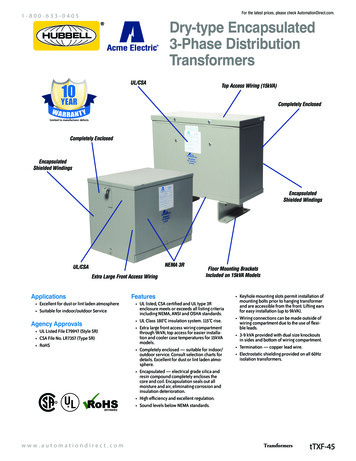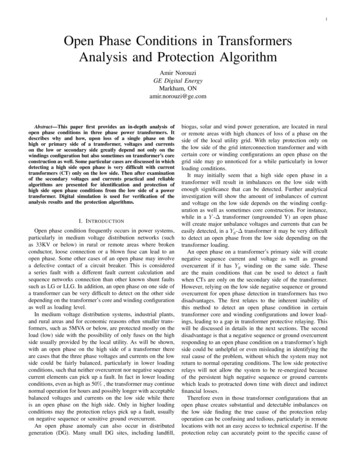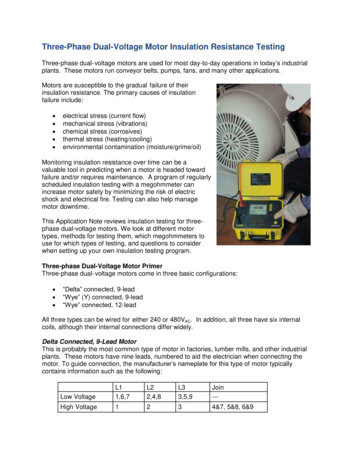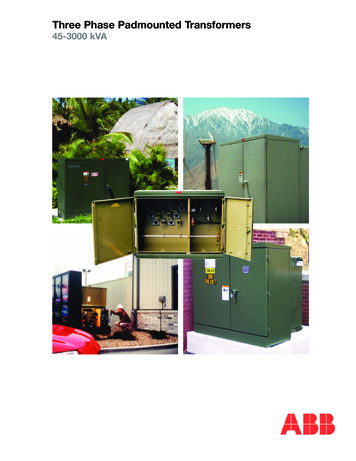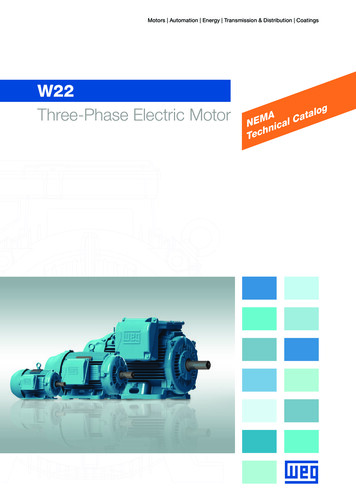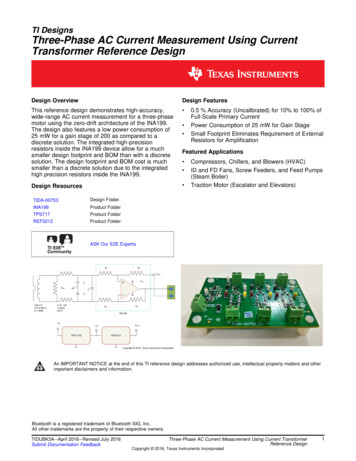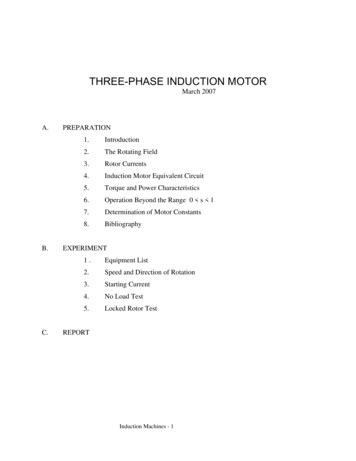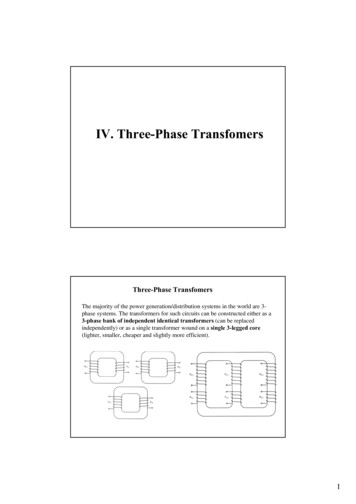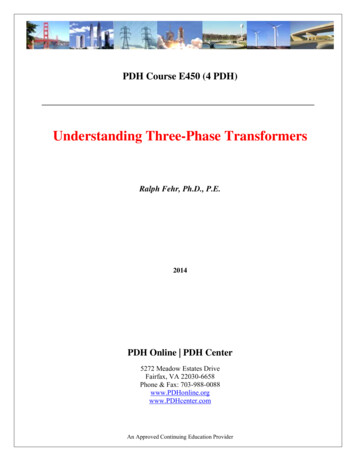
Transcription
PDH Course E450 (4 PDH)Understanding Three-Phase TransformersRalph Fehr, Ph.D., P.E.2014PDH Online PDH Center5272 Meadow Estates DriveFairfax, VA 22030-6658Phone & Fax: 703-988-0088www.PDHonline.orgwww.PDHcenter.comAn Approved Continuing Education Provider
www.PDHcenter.comPDHonline Course E450www.PDHonline.orgUnderstanding Three-Phase TransformersRalph Fehr, Ph.D., P.E.Transformers are indispensible components of a power system. By allowing voltage andcurrent levels to be adjusted, transformers solve many practical problems that would otherwisebe very difficult to overcome. For example, if power is generated at a reasonable generationvoltage, say 18 kV, without the ability to change voltage levels, all circuits supplied by thatgenerator would have to operate at 18 kV. Generating power at a substantially higher voltageis not practical due to insulation design issues involving rotating machines. For a given amountof power, an 18 kV circuit must carry a certain number of amperes of current. If the generatoris rated at 500 MVA, the three-phase current would beI 500,000 kVA 16,038 A.18 kV 3Such a high current would produce excessive voltage drop and losses. Both of these issuescould be overcome by reducing the current to a more manageable level. When this is done, thevoltage will increase by the same ratio that the current was decreased. The term step-uptransformer is used to describe such a transformer, as this describes what the transformer doesto the voltage. The relationships involving voltage and current will be explored in the nextsection.The Ideal TransformerTransformers are best understood by first considering and comprehending the idealtransformer. An ideal transformer is simply two coils of wire that are electrically isolated fromeach other and are magnetically coupled . Being “ideal,” the magnetic coupling between thecoils is perfect. In other words, all the magnetic flux produced by one winding links the otherwinding, so there is no stray flux. The self-inductance and the resistance of each winding arealso disregarded. Only the mutual inductance between the windings is considered.Per Faraday’s law, when a time-varying magnetic flux cuts a conductor formed into a coil withN turns, a voltage is induced across the coil.V NdΦdtLenz’s law determines the polarity of that voltage. The negative sign in Faraday’s lawindicates that the induced voltage is developed with a polarity that would produce a current (ifthe coil being considered is part of a closed circuit) that would produce a magnetic flux thatwould oppose the original flux. Fig. 1 shows, by the right-hand rule, that the current I producesa flux that opposes the original flux. This stipulation is necessary for the conservation ofenergy. 2014 Ralph FehrPage 2 of 17
www.PDHcenter.comPDHonline Course E450 Produced Flux www.PDHonline.orgOriginal Flux IFIGURE 1Lenz’s LawVIThe time-varying flux is produced by a time-varying current flowing in one of the coils. Byconvention, the coil across which a voltage is applied is called the primary winding, and thecoil across which a voltage is induced is called the secondary winding. Since it may not beknown which winding will have a voltage applied across it, the use of primary and secondarycan be risky. Transformer manufacturers always designate the windings “high voltage” and“low voltage” to avoid this issue.In an ideal transformer, the ratio of the number of turns on the high-voltage winding (NH) to thenumber of turns on the low-voltage winding (NL) defines the turns ratio (n) for the transformer.The turns ratio also describes the ratio of the voltages across the two windings, so is alsoreferred to as the voltage ratio. If each winding in the ideal transformer is part of a closedcircuit, the ratio of the currents that flow through each winding is inversely proportional to theturns ratio. These ratios are shown in Fig. 2.IHILVHVLNHn NHNLNHV HNLVLNHI LNLIHFIGURE 2The Ideal TransformerNLSince the ideal transformer is lossless, the power handled by the high-voltage winding mustequal the power handled by the low-voltage winding.VH IH VL IL 2014 Ralph FehrPage 3 of 17
www.PDHcenter.comPDHonline Course E450www.PDHonline.orgAlso, an impedance put across the low-voltage windings appears to be a much higherimpedance when viewed from the high-voltage circuit. This can be seen by writing the highvoltage circuit quantities in terms of the low-voltage circuit quantities:VH n VLIH 1ILnDividing the voltage equation by the current equation givesZH n2 ZL.Transformer Circuit ModelThe characteristics that were disregarded in the ideal transformer model can be accounted for ina lumped-parameter circuit model to realistically represent an actual transformer. Figure 3shows a circuit model representing an actual transformer.IHVHRHGCXHRLXLILVLBCNH NLidealFIGURE 3Transformer Circuit ModelThe resistances RH and RL represent the resistances of the high-voltage and the low-voltagewindings, respectively. The inductive reactances XH and XL represent the self-inductances ofthe high-voltage and the low-voltage windings, respectively, multiplied by the radianfrequency.XH ωLH 2πf LHXL ωLL 2πf LLGC paralleled with BC make up the core branch of the model. GC is the shunt conductancerepresenting hysteresis and eddy currents. BC is the shunt susceptance which represents themagnetization current for the core. The total current flowing through both GC and BC voltagedependent and is the no-load current of the transformer, and can be measured using the opencircuit test, which measures IH with the low-voltage terminals open-circuited. 2014 Ralph FehrPage 4 of 17
www.PDHcenter.comPDHonline Course E450www.PDHonline.orgThe losses in a transformer are very low compared to the amount of power the transformer canhandle; in fact, transformers are among the most efficient machines that can be built, withefficiencies of large transformers often exceeding 99%. But even at a loss rate of 1%, thelosses in a transformer should not be overlooked. Think about the losses in a 750 MVAgenerator step-up transformer with an efficiency of 99% -- that’s 7.5 MW of losses (enough tosupply about 1500 homes with electricity!)The ideal transformer provides the turns ratio for the model. Although fairly straightforward,the turns ratio complicates calculations involving systems containing transformers. In the nextsection, a calculation method will be introduced that makes each transformer turns ratio in thesystem appear to be 1:1, thereby effectively eliminating the transformers and making the entireelectrical system to appear as a single circuit. That calculation method is the per-unit system.The Per-Unit System of CalculationThe complications caused by the transformer turns ratio are actually quite serious and need tobe analyzed. Consider the following one-line diagram, showing a transformer with turns ratio nsupplied from a bus operating at voltage VH and drawing current IH. The transformer, then,delivers current IL to the low voltage bus, which operates at voltage VL. A load impedance ZLis connected to the low voltage bus.VHIHnVLILFIGURE 4One-Line DiagramZLThe first step in analyzing the system shown in Fig. 4 is to convert the one-line diagram to acircuit. To do this, an equivalent circuit must replace the transformer one-line symbol. Thecircuit shown in Fig. 3 would work, but for many types of calculations, a simpler model wouldsuffice. For example, the core branch of the transformer equivalent circuit can be ignoredwhen doing voltage drop calculations, as doing so has little effect on the answer. And for shortcircuit calculations, the winding resistances can also be ignored, since the very inductive faultcurrent produces little voltage drop across the resistances. And since the X/R ratio of atransformer tends to be large, X R, giving further justification to neglect the resistances. Sofor fault calculations, the transformer equivalent circuit could be shown as a single inductivereactance (the X on one side of the ideal transformer could be reflected to the other side of the 2014 Ralph FehrPage 5 of 17
www.PDHcenter.comPDHonline Course E450www.PDHonline.orgideal transformer, then the two reactances could be combined in series to yield a singlereactance. This circuit is shown in Fig. 5.VHIHXxfmr-equiv.VLVHVLILFIGURE 5Circuit representationof Figure 4ZLExamining Fig. 5, a serious problem is realized: the current entering the inductancerepresenting the transformer is different from the current leaving the inductance (IH IL). Thisseems like a violation of Kirchhoff’s Current Law (KCL), but KCL applies to an electriccircuit. The transformer is actually two electric circuits linked by a magnetic circuit. Whilethat technicality explains the apparent KCL violation, the fact that IH IL is still a problem.Recall the three equations describing how magnitudes change when moving from one electriccircuit of a transformer to the other:1VH n VL, I H I L , and ZH n2 ZL.nThere is one specific value of turns ratio that makes high-side current and low-side currentequal, namely n 1. If n 1, then the circuit in Fig. 5 can be analyzed. In fact, if n 1, then VH VL, IH IL, and ZH ZL. But other than building a transformer with an equal number of turnson both windings (as with an isolation transformer), how can n 1? Perhaps some mathematicaltrickery can be used to make n appear to have a value of 1. This “trickery” is the per-unitsystem.The per-unit system uses dimensionless quantities instead of electrical units (volts, amps, ohms,watts, etc.). The per-unit system, when properly applied, changes all transformer turns ratios to1. This way, as one moves from the high-voltage circuit of the transformer to the low-voltagecircuit, the voltage, current, and impedance are all unaffected, making the two electric circuitsappear as one.The per-unit system relies on the establishment of four base quantities. The required basequantities are: base power, base voltage, base current, and base impedance. The basequantities are selected by the person doing the problem. The numeric values of these basequantities are arbitrary – any number will work except zero. This is because the per-unitsystem is a linear mathematical transformation. The problem to be solved is transformed intothe per-unit system, solved, and then transformed back to electrical quantities. Since thetransformation back to electrical quantities is the inverse of the transformation into the per-unit 2014 Ralph FehrPage 6 of 17
www.PDHcenter.comPDHonline Course E450www.PDHonline.orgsystem, the base quantities which define the transformations can assume any non-zero numericvalue.Of the four base quantities, two are mathematically independent. The other two are thendefined by the first two. For example, if voltage and current are assumed to be independent,power can be thought of as the product of voltage and current, and impedance as the quotient ofvoltage and current. The typical way to apply the per-unit system is to arbitrarily assign thepower and voltage bases, then using the mathematical relationships between the electricalquantities to determine the current and impedance bases.Typically, the base power (kVA or MVA base) is selected arbitrarily, often as 10 or 100 MVA.The power base is constant through the entire system. The base voltage (kV base) is frequentlyassigned as the nominal operating voltage at a given point in the system. At every voltagetransformation, the base voltage is adjusted by the transformer turns ratio. Therefore, manydifferent base voltages may exist throughout the system. The proper selection of voltage basesthroughout the system effectively makes the transformer turns ratios equal to one, thusremoving the complications introduced by the transformer turns ratios.After the power and voltage bases are chosen, the other two base quantities can be calculatedfrom the established bases by using the formulasBase Current Base kVA 3 3 Base kVL LandBase Impedance Base kVL L 2 ,Base MVA 3 where the subscripts 3Φ and L–L respectively denote three-phase power and line-to-linevoltage.Actual electrical quantities are converted to dimensionless per-unit quantities using the formulaPer Unit Quantity Actual Quantity.Base QuantityOften, a per-unit quantity must be converted from a particular base to a new base. Toward thatend, we use the relationshipPer Unit Quantity New Per Unit Quantity Old 2014 Ralph Fehr kV Base Old kV Base New2 kVA Base New kVA Base Old . Page 7 of 17
www.PDHcenter.comPDHonline Course E450www.PDHonline.orgConsider the power system shown below:UtilityGXnRated Voltages:T1T2Utility Source: 12.47 kVXnGenerator: 460 V1TransformersT1: 13.2 kV / 4.16 kVT2: 460 V / 4 kVT3: 4.16 kV / 480 VM1FIGURE 6Example PowerSystemT3MotorsM1: 4000 VM2: 460 V2M2If the base voltage at Bus 1 is arbitrarily chosen to be 4.16 kV, what must be the base voltagesat the utility connection point, the generator terminals, and Bus 2 so that the turns ratio of eachtransformer appears to be 1?Starting with the given base voltage at Bus 1 and applying the turns ratio of transformer T1, 13.2 kV 13.2 kV .Vbase ( Utility ) 4.16 kV 4.16 kV Starting with the given base voltage at Bus 1 and applying the turns ratio of transformer T2, 460 V Vbase ( Generator ) 4.16 kV 478.4 V . 4000 V Starting with the given base voltage at Bus 1 and applying the turns ratio of transformer T3, 480 V 480 V .Vbase ( Bus 2 ) 4.16 kV 4160 V So the base voltage at one random bus is arbitrary, but every other bus has its base voltagedefined by the arbitrarily chosen voltage base multiplied by the product of the turns ratios ofeach transformer one must pass through to get from the arbitrarily-assigned bus to the busbeing considered. This process of assigning base voltages makes each turns ratio appear to be1. 2014 Ralph FehrPage 8 of 17
www.PDHcenter.comPDHonline Course E450www.PDHonline.orgTransformer ImpedanceA transformer’s impedance is an important parameter that helps determine itssuitability for a given application. Transformer impedance is expressed inpercent based on the self-cooled kVA rating. The impedance is numerically equalto the percentage of rated voltage that would have to be applied to the primaryterminals to cause rated current to flow from the short-circuited secondaryterminals. This concept is illustrated in Fig. 7, where x equals the nameplatevalue %Z of the transformer.xxFIGURE 7Definition of Transformer ImpedanceNote that the percent impedance, which is simply the per unit impedance times100, is numerically the same whether referred to the high-voltage circuit or thelow-voltage circuit. If the impedance were expressed in ohms, the ohmic valuewould differ by a factor of n2 when viewed through the transformer. Also, theohmic impedance would vary tremendously, over orders of magnitude, whencomparing very large transformers to very small transformers, while the percentimpedance varies over a rather small range, say 2% to 14%, regardless of the sizeof the transformer.Transformer impedance varies according to design parameters, particularly kVArating and basic lightning impulse insulation level (BIL). In general, impedanceincreases with kVA rating, and also increases with BIL. Most substation classtransformers have an impedance in the 5.5% to 7.5% range, but specific designscan cause the impedance to lie outside this range. Since transformer impedance iscritical for calculating voltage drop and short circuit magnitudes, actualnameplate data should be used whenever possible.Common Three-Phase ConnectionsAlthough many three-phase transformer connections, two particular connections, the delta andthe wye, make up most of the three-phase connections commonly encountered. It is important 2014 Ralph FehrPage 9 of 17
www.PDHcenter.comPDHonline Course E450www.PDHonline.orgto understand the advantages and disadvantages of each connection type so the propertransformer connections can be determined for a given application.The Delta ConnectionThe delta connection is usually a three-wire, ungrounded circuit. Delta circuits work well tosupply balanced loads, such as three-phase motors. Requiring only three conductors, deltaconnected circuits are economical to construct. As the load currents supplied by the deltacircuit become unbalanced, the voltages also become unbalanced. Unbalanced voltages canlead to operational problems, particularly for three-phase motors. Also, being an ungroundedfault, ground fault protection is complicated and ground faults require more time to clear thanthey would on a comparable grounded system. Delta-connected circuits block zero-sequencecurrents and triplen harmonics by providing a path in which they can circulate, which can beadvantageous on systems containing large magnitudes of harmonic currents. And deltaconnected circuits provide only one three-phase voltage – the line-to-line voltage.The Wye ConnectionThe wye connection is usually a four-wire, grounded circuit. Wye circuits are desirable tosupply single-phase loads, as these loads frequently become unbalanced. As the load currentssupplied by the wye circuit become unbalanced, the voltages tend to remain well balanced, asthe current imbalance is returned to the source by the fourth, or neutral, conductor. Wyeconnected windings have no effect on zero-sequence currents or triplen harmonics. The groundreference provides fast detection and clearing of ground faults, and wye-connected systemsprovide both line-to-line and line-to-neutral voltages. Single-phase loads are usually connectedline-to-neutral to keep the phase voltages balanced.The Delta-Wye TransformerMany of the advantages of the delta connection and the wye connection can be realized whenconstructing a three phase transformer having one set of windings configured in delta and theother set of windings configured in wye. This configuration, the delta-wye transformer, is themost common three-phase transformer configuration.A delta-wye transformation can be accomplished in two different ways. Three identical singlephase transformers can be externally connected to form a delta-wye bank. Or, three sets ofwindings connected in delta and three sets of windings connected in wye can be wound on asingle three-phase core. While the two designs are very much different in their magneticcircuits, they are electrically identical. While many delta-wye transformers may be constructedas a single three-phase unit, it may be clearer to visualize and analyze the device as threesingle-phase transformers. 2014 Ralph FehrPage 10 of 17
www.PDHcenter.comPDHonline Course E450www.PDHonline.orgFIGURE 9Core and Coil Assemblyof a Three-PhaseDelta-Wye TransformerFIGURE 8Three Single-Phase Transformersin a Delta-Wye BankFigure 10 shows a delta-wye transformer in four different ways: as a connection diagram, as aschematic diagram, as a phasor diagram, and mathematically. Some relationships may be seenmore easily in one of the four formats than the others. By having all four in front of you, youwill more easily learn how the delta-wye transformer X2IAIaH2BIBH3CICIaH2X2H1X1IbX2H1X1H2X2IcbIcI B I b - I c I b x 3 30 bIbcIcIBIcI A I a - I b I a x 3 30 cInX3H2IbX3nIcICBIbH2IcIaIaX0IcH3CaIaH1AIAICIaI C I c - I a I c x 3 30 IbX2IBFIGURE 10Delta-Wye Transformer 2014 Ralph FehrPage 11 of 17
www.PDHcenter.comPDHonline Course E450www.PDHonline.orgStarting with the connection diagram on the left, both single-phase and three-phaseimplementations can be seen. Looking at the large dashed rectangle and ignoring the threesmaller dashed rectangles, the three-phase implementation is shown. The large dashedrectangle represents the tank of the three-phase unit. Everything inside the rectangle is internalto the transformer. The internal connections are made at the factory and cannot be changes.Seven bushings provide access to install the transformer. On the left, bushings H1, H2, and H3are the high-voltage bushings and provide connection points for the high-voltage phases. Onthe right, bushings X1, X2, and X3 provide connection points for the low-voltage phases, andbushing X0 provides access to the neutral.Alternately, the large dashed rectangle can be ignored, and the three smaller dashed rectanglesrepresent the tanks of three single-phase transformers that can also provide the delta-wyetransformation. Each single-phase transformer has four bushings (H1, H2, X1, and X2). Theconnections between these bushings are made up with insulated cable jumpers interconnectingthe three transformers. These jumpers are clearly seen in Fig. 8.Identifying the delta- and wye-connected windings on the connection diagram is difficult,although by starting at the H1 end of the red winding, moving through the red winding, thenfollowing the jumper from red H2 to blue H1, through the blue winding, then following thejumper from blue H2 to green H1, through the green winding, then following the jumper fromgreen H2 to red H1, the high-voltage delta can be traced. Similarly, the non-polarity (X2) endsof the three low-voltage windings are tied together and connected to the X0 bushing, while thepolarity (X1) ends of the windings are connected to bushings X1 through X3, thus forming awye connection. The delta and wye are much more obvious on the schematic diagram in thetop right of Fig. 10.To develop the phasor diagram and the mathematical relationships, we must analyze thebehavior of the delta-wye transformer. We can perform the analysis using a voltage-based or acurrent-based method. Voltage, being a subtraction of two potential phasors (potentialdifference) is very abstract and difficult, if not impossible, to visualize. Current on the otherhand is simply a flow of electrical charges, and can easily be visualized. So we will develop amethod of current-based analysis and apply it to the delta-wye transformer. This generalmethod can be applied to any type of transformer connection, regardless of its complexity. If avoltage analysis is needed, the current-based method can still be used, and since Ohm’s lawstates that voltage and current are linearly dependent, the I variables can be replaced with Vvariables in the last step of the analysis, thus giving a voltage analysis of the transformer.To begin the current-based analysis, we start with the electric circuit where the line currentequals the phase current. This is the wye circuit since the line currents (labeled Ia, Ib, and Ic)are the same as the currents through the windings (phase currents), as can be seen in Fig. 11.This is not the case with the delta circuit. 2014 Ralph FehrPage 12 of 17
www.PDHcenter.comPDHonline Course 3H2cIcFIGURE 11Delta-Wye Transformer Schematic DiagramAfter all the currents in the wye circuit are labeled, the currents in the delta-connected windingscan be labeled. The current flowing in a high-voltage winding is smaller than the currentflowing in the corresponding low-voltage winding by a factor of 1/n, where n is the turns ratio.Carrying factors of 1/n through the analysis would be cumbersome. If per-unit currents areused, the current flowing through the high-voltage winding equals the current flowing throughthe corresponding low voltage winding, since the per-unit system makes the turns ratio appearto be 1. The direction of the high-voltage winding currents is determined by the dotconvention. If an instantaneous current direction is out of the dotted terminal in the low-voltagecircuit, the high-voltage winding will have a current flowing into its dotted terminal. So, usingper-unit currents, the currents through the high-voltage windings can be labeled, as shown inFig. 12.X1AIaCIbIcH3IbIcH2IaX0X2BaIaH1X3nInbIbcIcFIGURE 12High-Voltage Winding Currents LabeledFinally, the high-voltage circuit line currents can be determined by writing node equations atthe corners of the delta. Upper-case subscripts are used to distinguish high-voltage linecurrents from low-voltage line currents, and the high-voltage line currents are drawn flowinginto the transformer, as shown in Fig. 13. 2014 Ralph FehrPage 13 of 17
www.PDHcenter.comPDHonline Course CaIaH1AnInbIbcIcIBFIGURE 13High-Voltage Circuit Line Currents labeledAt the top corner of the delta,IA Ia – Ib.Similarly, at the other two nodes,IB Ib– Ic and IC Ic– Ia.If a balanced set of positive sequence (meaning the phasors are sequenced a-b-c) currents areassumed, the relationship between the high-voltage line currents and low-voltage line currentscan be found. Let Ia 1/0 , Ib 1/240 , and Ic 1/120 . Substituting these values into thenode equations developed above,IA Ia – Ib 1/0 – 1/240 3 /30 IB Ib – Ic 1/240 – 1/120 IC Ic – Ia 1/120 – 1/0 3 /270 3 /30 .Constructing a phasor diagram showing the three low-voltage circuit line currents and the threehigh-voltage line currents, as in Fig. 14, reveal the mathematical relationships between thecurrents.IcIAICIaIbIBFIGURE 14Phasor Diagram of Delta-Wye TransformerIt can be seen that each high-voltage circuit phasor is longer than its low-voltage circuitcounterpart by a factor of 3 and leads it by 30 . These relationships are shown in Fig. 15. 2014 Ralph FehrPage 14 of 17
www.PDHcenter.comPDHonline Course E450www.PDHonline.orgI A I a - I b I a x 3 30 I B I b - I c I b x 3 30 I C I c - I a I c x 3 30 FIGURE 15Mathematical Relationships betweenHigh-Voltage circuit Line Currents andLow-Voltage Circuit Line CurrentsIn this example, the high-voltage phasors lead the low-voltage phasors by 30 . This constitutesan ANSI Standard delta-wye transformer. Lagging high-voltage phasors would constitute anANSI Non-Standard delta-wye transformer. By using both standard and non-standardtransformers, and by connecting the phases to different bushings (instead of A to H1, B to H2,and C to H3 as in this example), a delta-wye transformer can produce phase shifts of 30 , 90 ,150 , 210 , 270 , and 330 .Please note that if voltage relationships are needed instead of current relationships, the Ivariables simply need to be changed to V variables.The per-unit current-based analysis of the delta-wye transformer that was just completed can beused to analyze any type of transformer connection. Let’s apply it to a more complicatedconnection. Figure 16 shows a three-winding transformer used to supply a six-phase systemfrom a three-phase source.VHIHVL1I L1I L2VL2FIGURE 16Three-Winding Transformer One-Line DiagramVH is a three-phase system which supplies the delta-connected high-voltage windings. The twowye-connected low-voltage windings differ in phase by 180 relative to each other, so the twolow-voltage buses VL1 and VL2 actually comprise a six-phase system. High phase order systemsuch as this are excellent for supplying electronic load, such as variable-frequency drives, asthey produce less harmonic content than a three-phase system would. The schematic diagramfor this transformer is shown in Fig. 17. Please note that although the neutral is drawn as partof bus VL1, it is actually shared by both VL1 and VL2. 2014 Ralph FehrPage 15 of 17
www.PDHcenter.comPDHonline Course IfIdIeVL2IeFIGURE 17Three-Winding Transformer Schematic DiagramWhen transferring the transformer winding currents from the low-voltage circuits to the highvoltage circuit, careful attention must be paid to the winding polarities. Looking at the bluewinding, current Ia leaves the dotted terminal, so an equal per-unit current must enter the dottedterminal on the high-voltage side. But in circuit VL2, current Id enters the dotted terminal of theblue winding, so a current Id must leave the blue winding in the high-voltage circuit. Thismeans Ia and Id oppose each other in the high-voltage, and that they are 180 out of phase in thelow-voltage circuits. So in the high-voltage circuit, a net current of Ia – Id will be shownflowing into the dotted terminal. The other windings are treated similarly, as shown in Fig. 18.IaIaIBIb - IeIbVL1InIcIc - IfIbIcVHIAICIa - IdIdIfIeIfIdVL2IeFIGURE 18Schematic Diagram with All Currents Labeled 2014 Ralph FehrPage 16 of 17
www.PDHcenter.comPDHonline Course E450www.PDHonline.orgNow, a balanced set of positively-sequenced phasors can be assumed for one of the low-voltagecircuits. Starting with VL1, we can assume Ia 1/0 , Ib 1/240 , and Ic 1/120 . Since thepolarities of the VL2 windings are opposite from the VL1 windings. We know the correspondingcurrents are 180 out of phase from their VL1 counterparts. This means Id 1/180 , Ie 1/60 ,and If 1/300 . Using these values, the high-side line currents can be found by writing nodeequations at each corner of the delta.IA (Ia – Id) – (Ib – Ie) Ia Ie – Ib – Id 1/0 1/60 – 1/240 – 1/180 2 3 /30 IB (Ib – Ie) – (Ic – If) Ib If – Ic – Ie 1/240 1/300 – 1/120 – 1/60 2 3 /270 IC (Ic – If) – (Ia – Id) Ic Id – Ia – If 1/120 1/180 – 1/0 – 1/300 2 3 /150 Now, a phasor diagram can be constructed showing all nine line currents.ICIAIcIeIdIaIbIfIBFIGURE 19Three-Winding Transformer Phasor Diagram 2014 Ralph FehrPage 17 of 17
The transformer, then, delivers current IL to the low voltage bus, which operates at voltage VL. A load impedance ZL is connected to the low voltage bus. V H V L I H I L n. Z L. The first step in analyzing the system shown in Fig. 4 is to convert the one-line diagram to a circuit. To do this, an equivalent

